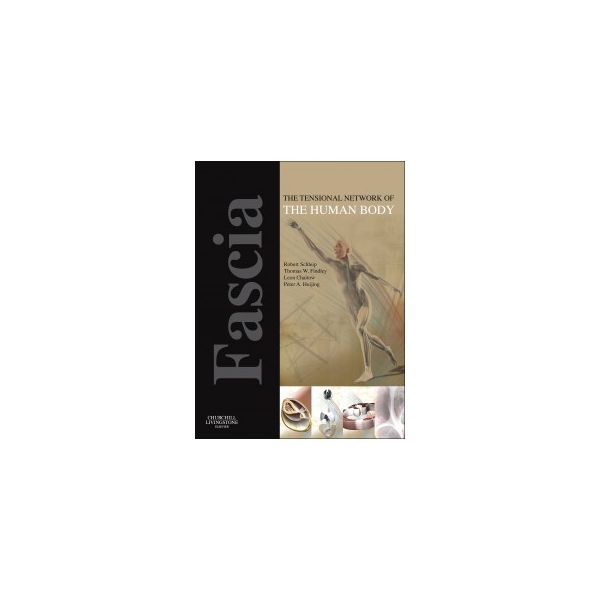Fascia:Tensional Network Human Body 1E
Compiled by experts of international renown, Fascia: The Tensional Network of the Human Body brings together very different contributors who share the desire to bridge the gap between theory and practice as much as possible in our current knowledge of the human fascia. With contributions from over 100 specialists and researchers from throughout the world, this new volume will be ideal for all professionals who have an interest in fascia and human movement - physiotherapists, osteopathic physicians and osteopaths, chiropractors, structural integration practitioners, manual therapists, massage therapists, acupuncturists, yoga or Pilates instructors, exercise scientists and personal trainers - as well as physicians involved with musculoskeletal medicine, pain management and rehabilitation, and basic scientists working in the field.
| Author | Schleip Findley Chaitow Huijing |
|---|---|
| Table Of Content | SECTION I SCIENTIFIC FOUNDATIONS Part 1 Anatomy of the fascial body 1.1 General anatomy of muscular fasciae 1.2 Somatic fascia 1.3 Fascia superficialis 1.4 Deep fascia of the shoulder and arm 1.5 Deep fascia of the lower limbs 1.6 The thoracolumbar fascia: An integrated functional view of the anatomy of the TLF and coupled structures 1.7 The deeper fasciae of the neck and ventral torso 1.8 Visceral fascia 1.9 Membranous structures within the cranial bowl and intraspinal space 1.10 Diaphragmatic structures Part 2 Fascia as an organ of communication 2.1 Fascia as an organ of communication 2.2 Proprioception 2.3 Interoception: A new correlate for intricate connections between fascial receptors, emotion and self recognition 2.4 Nociception: The thoracolumbar fascia as a sensory organ 2.5 Fascia as a body-wide communication system Part 3 Fascial force transmission 3.1 Force transmission and muscle mechanics: General principles 3.2 Myofascial force transmission: An introduction 3.3 Myofascial chains: A review of different models 3.4 Anatomy trains and force transmission 3.5 Biotensegrity: The mechanics of fascia 3.6 The subcutaneous and epitendinous tissue behaviour of the multimicrovacuolar sliding system Part 4 Physiology of fascial tissues 4.1 The Physiology of fascia: An introduction 4.2 Fascia is alive: How cells modulate the tonicity and architecture of fascial tissues 4.3 Extracellular matrix 4.4 The influence of pH and other metabolic factors on fascial properties 4.5 Fluid dynamics in fascial tissues SECTION II CLINICAL APPLICATION Part 5 Fascia-related disorders 5.1 Fascia-related disorders: An introduction 5.2 Dupuytren&aposs disease and other fibrocontractive disorders 5.3 &aposFrozen shoulder&apos 5.4 Spastic paresis 5.5 Diabetic foot 5.6 Scleroderma and related conditions 5.7 Trigger points (TrP) as a fascia-related disorder 5.8 Fascia-related disorders: hypermobility 5.9 Anatomy of the plantar fascia Part 6 Diagnostic procedures for fascial elasticity 6.1 Diagnostic procedures for fascial elasticity : An introduction 6.2 Fascial palpation 6.3 Hypermobility and the hypermobility syndrome: assessment and management Part 7 Fascia-oriented therapies 7.1 Inclusion criteria and overview 7.2 Trigger Point Therapy 7.3 Rolfing® Structural Integration 7.4 Myofascial induction approaches 7.5 Osteopathic manipulative therapies and fascia 7.6 Connective tissue manipulation 7.7 Fascial manipulation 7.8 Managing dysfunctional scar tissue 7.9 Acupuncture as a fascia-oriented therapy 7.10 Gua shua 7.11 Prolotherapy 7.12 Neural therapy 7.13 Dynamic fascial release: Manual and tool assisted vibrational therapies 7.14 Graston Technique®:A contemporary instrument assisted mobilization method for the evaluation & treatment of soft tissue lesions 7.15 The Fascial Distortion Model 7.16 Frequency specific microcurrent 7.17 Surgery and scarring 7.18 Temperature effects on fascia 7.19 Neurodynamics: Movement for neuropathic pain states 7.20 Stretching and fascia 7.21 Fascia in yoga therapeutics 7.22 Pilates and Fascia: The art of &aposWorking In&apos 7.23 Nutrition model to reduce inflammation in musculoskeletal and joint diseases 7.24 Fascial fitness: Suggestions for a fascia oriented training approach in sports and movement therapies SECTION III RESEARCH DIRECTIONS Part 8 Fascia research: methodological challenges and new directions 8.1 Fascia, the clinic and fundamental scientific research: Considering the scientific process 8.2 Imaging: Ultrasound 8.3 MRI and Elastography 8.4 Roles of fascia in molecular biology of adaptation of muscle size 8.5 Mathematical modelling Glossary |
| Format | 246 X 189 (7 11/16 x 9 7/16) |
| Page Count | 534 |
| Publish Date | 10 Apr 2012 |





